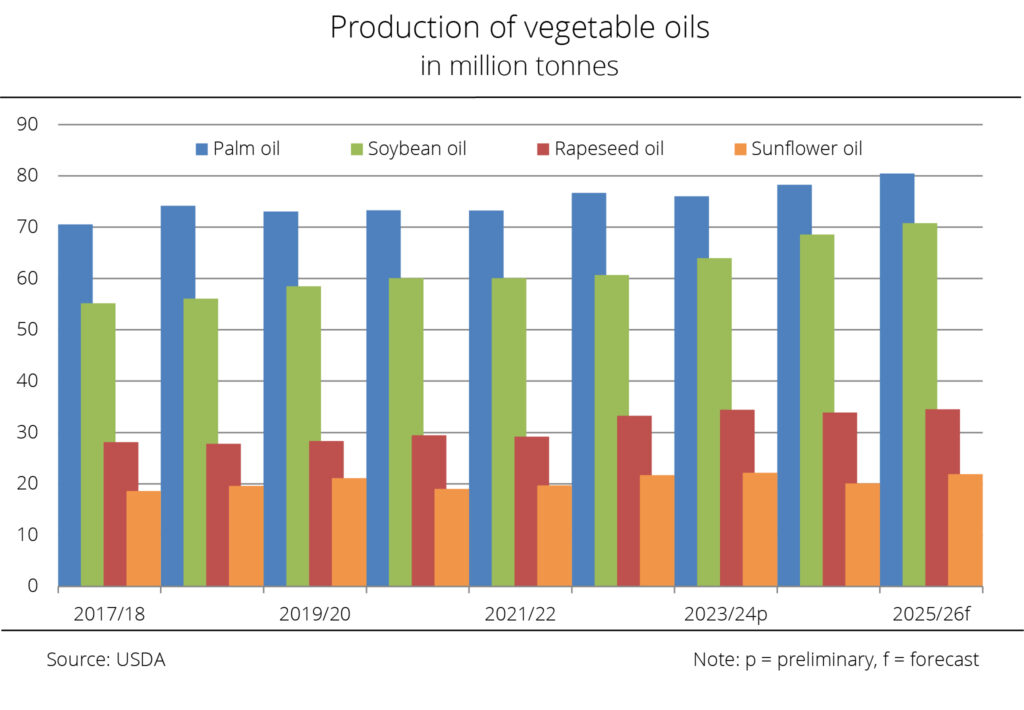
According to the latest outlook published by the US Department of Agriculture (USDA), global production of vegetable oils in 2025/26 is expected to reach 234.5 million tonnes. This would represent a 6.7 million tonnes rise compared to 2024/25. In other words, production could fully cover the projected demand of 228.9 million tonnes.
According to research by Agrarmarkt Informations-Gesellschaft (mbH), palm oil is set to remain the world’s most important vegetable oil in terms of production and consumption, with global output estimated at a record 80.4 million tonnes. This translates to a 2.2 million tonne increase over 2024/25. Indonesia remains the largest producer with an output of 47.5 million tonnes, followed by Malaysia with 19.2 million tonnes and Thailand with just under 3.4 million tonnes.
Soybean oil production is expected to grow just under 2.2 million tonnes to 70.8 million tonnes in the coming crop year, potentially setting a new record. China, by far the largest importer of soybeans, remains the main producer of soybean oil with 20.5 million tonnes, followed by the US with just over 13.3 million tonnes. Production of rapeseed oil is projected to rise 617,000 tonnes to a total of 34.5 million tonnes in 2025/26. Sunflower seed oil output is seen to grow around 1.8 million tonnes to 21.9 million tonnes, primarily due to higher production in Ukraine and the EU-27.
Amid the ongoing critical debate on the eligibility of biofuels derived from waste oils, the Union zur Förderung von Oel- und Proteinpflanzen e.V. (UFOP) has renewed its criticism of the double counting of so-called advanced biofuels from defined waste categories. The UFOP argues that the term is misleading, because the Renewable Energy Directive (RED II) allows double counting only if feedstocks are processed using innovative technology, a requirement also stipulated by the Delegated Directive EU 2024/1405. The association has called on Federal Environment Minister Schneider to put an end to what it describes as an incentive to commit fraud by categorically excluding the eligibility of POME-based biofuels in the forthcoming revision of the Federal Immission Control Ordinance (BImSchG). Market research shows that POME (Palm Oil Mill Effluent) is in fact “produced” rather than exclusively obtained as a by-product.
The UFOP argues that on the assumption that 5 per cent to 10 per cent of global vegetable oil production could be collected as waste oils, the volume of waste oils would amount to between 11.7 and 23.4 million tonnes globally. However, the association urges that this globally available volume be properly categorised within a redesigned subsidy framework for both national and European fuel markets, reasoning that competition for waste oils – from sectors such as shipping and aviation – is set to increase not only within the EU but worldwide.
The legal cap on the share of biofuels derived from waste oils under Part B of ANNEX IX of RED II to 1.7 per cent and 1.9 per cent in Germany already reflects the political will to impose necessary limits. The UFOP has emphasised that, after all, waste oils are also derived from “cultivated biomass, including from palm oil plantations”. The fact that this cap does not apply to waste oils listed in Part A represents a flaw in policy design. According to the association, in combination with double counting, this increases incentives for fraud at the expense of the entire biofuel supply chain, including agriculture. The UFOP has therefore called for this regulatory loophole to be closed. The association has emphasised the need for a technology- and feedstock-neutral approach to all greenhouse gas reduction options in the transport sector to ensure that the 2030 climate protection targets remain achievable.
Source
UFOP, Chart of the week 21/2025, press release, 2025-05-21.
Supplier
Agrarmarkt Informations-GmbH (AMI)
Union zur Förderung von Oel- und Proteinpflanzen e.V. (UFOP)
US Department of Agriculture (USDA)
Share
Renewable Carbon News – Daily Newsletter
Subscribe to our daily email newsletter – the world's leading newsletter on renewable materials and chemicals













